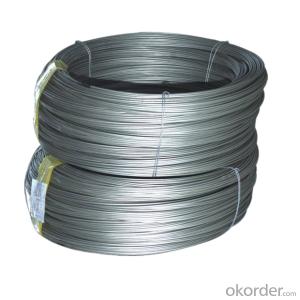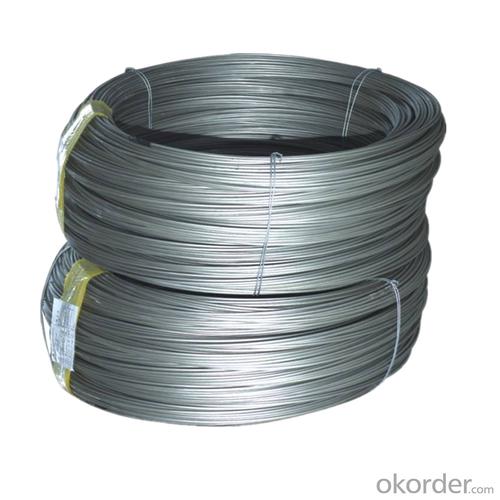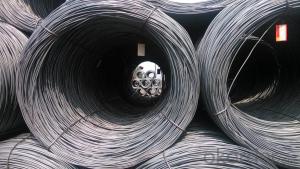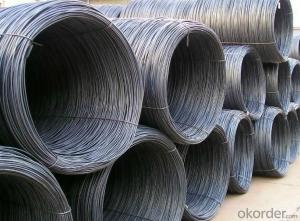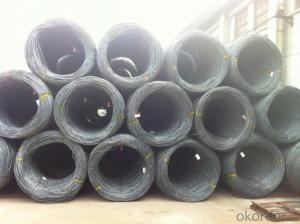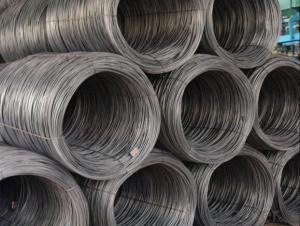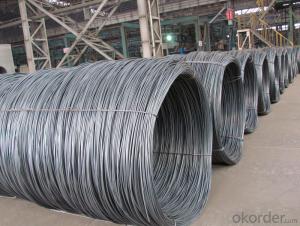Hot Rolled Steel Wire Rods in Coils SAE1008B
- Loading Port:
- Tianjin
- Payment Terms:
- TT OR LC
- Min Order Qty:
- 1000 m.t.
- Supply Capability:
- 1000000 m.t./month
OKorder Service Pledge
OKorder Financial Service
You Might Also Like
Specification
1. Introduction:
.commodity:steel wire rod
.grade:Q195,SAE1008B-SAE1018B
.diameter:5.5mm-14mm
.type:in coil
.coil weight:around 2 mt
2. Specifications:
wire rope can be drawn from Φ5.5mm-Φ12.00mm.
Annealing heat treatment and Phosphating are availiable as customer's requirement.
Productsteel wire rope
StandardAISI, ASTM, BS, DIN, GB, JIS
Material/steel gradeQ195-Q235,SAE1006B, SAE1008B, SAE1010B, SAE1018B, or according to customers requirements
Wire Gauge5.5-12mm
Coil weight1.8-2.1mts
MOQ25MT
Delivery Time15-30 days after receipt of L/C or deposit by T/T
PackingIn coil and load in container, if large quantity, by bulk vessel; Can be packed as customers' special requirements
Payment terms1).100% irrevocable L/C at sight.
2).30% T/T prepaid and the balance against the copy of B/L.
3).30% T/T prepaid and the balance against L/C
3.Application:
Applicationwidely used in machinery parts, manufacturing industry, electronics industry, metal tools and others
4. Pictures
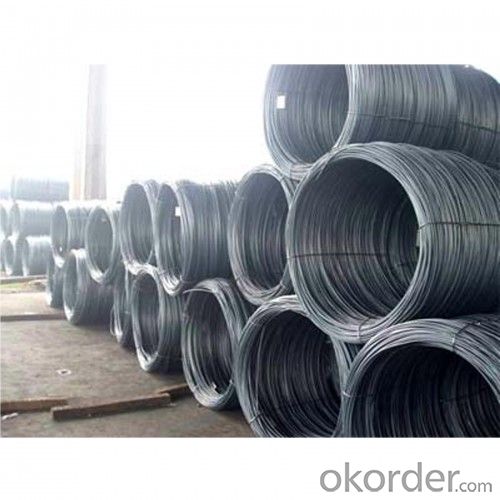
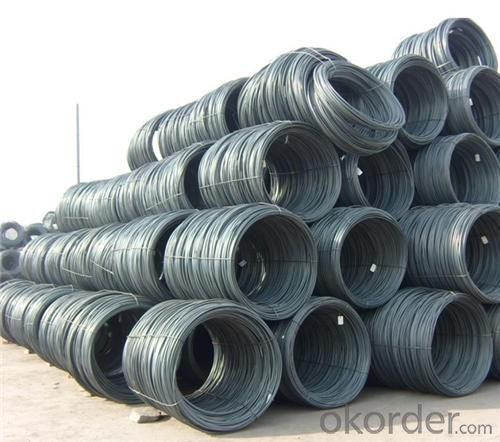
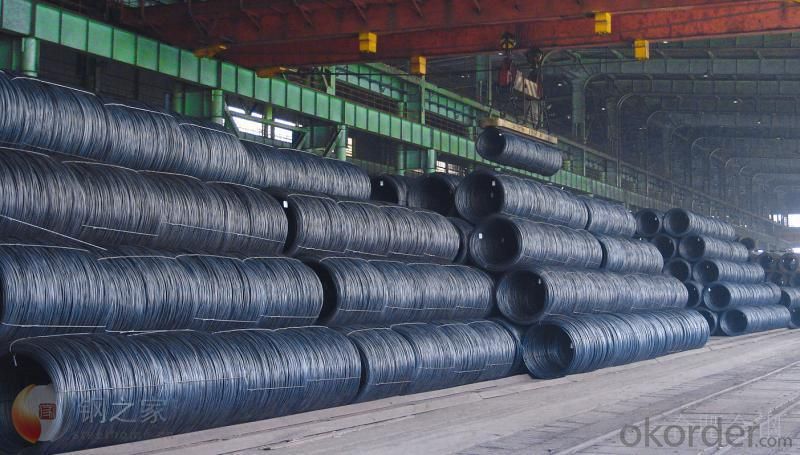
5.FAQ
We have organized several common questions for our clients,may help you sincerely:
①How about your company?
A world class manufacturer & supplier of castings forging in carbon steel and alloy steel,is one of the large-scale professional investment casting production bases in China,consisting of both casting foundry forging and machining factory. Annually more than 8000 tons Precision casting and forging parts are exported to markets in Europe,America and Japan. OEM casting and forging service available according to customer’s requirement.
②How to guarantee the quality of the products?
We have established the international advanced quality management system,every link from raw material to final product we have strict quality test;
- Q: Can steel wire rod be used in the production of fasteners?
- Certainly, the utilization of steel wire rod is possible in the manufacturing of fasteners. This multi-functional material possesses the capability to fabricate an extensive array of fasteners like screws, bolts, nuts, and rivets. It exhibits remarkable strength and durability characteristics, rendering it appropriate for a wide range of applications necessitating fasteners. Steel wire rod can be effortlessly manipulated, threaded, and molded to produce fasteners of various dimensions and structures. Furthermore, through heat treatment and surface treatment, the corrosion resistance and mechanical properties of steel wire rod can be enhanced, thereby augmenting its suitability for fastener production.
- Q: What are the main challenges in manufacturing steel wire rod?
- Manufacturing steel wire rod presents several primary challenges. Consistent quality and uniformity in production prove to be one of these challenges. This necessitates strict control over the steel's chemical composition and mechanical properties, as any deviation can impact the final product's performance and reliability. Consequently, adherence to quality control procedures and continuous monitoring throughout the manufacturing process become essential. Another hurdle is achieving the desired dimensional accuracy and surface finish of the wire rod. This requires precise regulation of temperature and speed during the rolling process to ensure proper shape and size. Any irregularities or defects in the wire rod can compromise its strength and durability, rendering it unsuitable for intended applications. Balancing high production rates with safety and minimizing downtime also poses a significant challenge. Complex machinery and equipment used in steel wire rod manufacturing necessitate regular maintenance and monitoring to prevent breakdowns. Additionally, ensuring worker safety in this environment requires the implementation of strict safety protocols and the provision of appropriate safety equipment. Environmental sustainability is yet another challenge in steel wire rod manufacturing. The production process consumes substantial energy and emits greenhouse gases. To reduce the industry's environmental impact, energy-efficient technologies must be implemented, waste materials should be recycled and reused, and sustainable practices adopted throughout the entire production chain. Moreover, the steel wire rod industry faces the challenge of increasing competition and fluctuating market demands. Manufacturers must remain up-to-date with market trends, adapt to changing customer requirements, and constantly innovate to stay competitive. This involves investing in research and development to enhance product quality, develop new alloys, and explore alternative manufacturing methods. In conclusion, addressing challenges related to quality control, dimensional accuracy, safety, environmental sustainability, and market competitiveness is crucial in manufacturing steel wire rod. Overcoming these challenges requires a combination of advanced technology, a skilled workforce, and continuous improvements in manufacturing processes.
- Q: What are the different shapes of steel wire rod available?
- There are various shapes of steel wire rods available, including round, square, hexagonal, and flat.
- Q: What are the main applications of steel wire rod in automotive manufacturing?
- Due to its robust and long-lasting properties, steel wire rod finds extensive use in the automotive manufacturing sector. This industry relies on steel wire rod for several key applications, including: 1. Suspension systems: Steel wire rod plays a vital role in the production of suspension systems, such as coil springs and torsion bars. These essential components ensure the stability and smoothness of a vehicle's ride. The strength of steel wire rod allows these components to endure heavy loads and deliver reliable performance. 2. Seat frames: Automotive seats often incorporate steel wire rod frames. The high tensile strength of steel wire rod guarantees that the seats can bear the weight of passengers and withstand the continuous stress and strain they experience during use. 3. Wire harnesses: Steel wire rod is indispensable in the manufacturing of wire harnesses, which form a crucial part of a vehicle's electrical system. These wire harnesses provide a dependable and organized means to route and secure electrical wires, ensuring the proper functioning of various electrical components like lights, sensors, and control systems. 4. Safety components: Steel wire rod finds applications in the production of various safety components in vehicles. For instance, it is commonly utilized in the manufacturing of seatbelt systems, where its high strength ensures the seatbelt's capability to restrain passengers during accidents. 5. Engine components: Engine components, including valve springs and piston rings, are manufactured using steel wire rod. These components need to possess high strength and durability to withstand the extreme conditions and constant movement within the engine. In conclusion, steel wire rod plays a critical role in the automotive manufacturing industry by enhancing the strength, safety, and performance of vehicles. Its versatility and ability to withstand heavy loads and stress make it an ideal material for various applications in this sector.
- Q: How is steel wire rod used in the manufacturing of wire forms for lighting fixtures?
- Steel wire rod is used in the manufacturing of wire forms for lighting fixtures as it serves as the primary raw material for creating various wire shapes and designs. The wire rod provides the necessary strength, durability, and malleability required for bending, twisting, and shaping the wire into the desired form. It is commonly used to create intricate structures such as lampshades, frames, and decorative elements, ensuring that the lighting fixtures are sturdy and aesthetically pleasing.
- Q: What are the different types of steel wire rod surface defect quantification methods?
- There are several different methods used to quantify surface defects on steel wire rods. These include visual inspection, optical microscopy, image analysis, and non-destructive testing techniques such as ultrasonic testing and magnetic particle inspection. Each method has its own advantages and limitations, but they all aim to accurately measure and classify surface defects on steel wire rods to ensure quality control and compliance with industry standards.
- Q: How are steel wire rods used in the manufacturing of bicycle spokes?
- Steel wire rods are used in the manufacturing of bicycle spokes by being drawn through a series of dies to achieve the desired diameter and strength. These rods are then cut into lengths, threaded at both ends, and attached to the bicycle hub and rim, providing the necessary support and tension to the wheel.
- Q: What are the standard cleanliness requirements for steel wire rod?
- The standard cleanliness requirements for steel wire rod involve several factors to ensure the quality and integrity of the product. These requirements typically include: 1. Surface cleanliness: The wire rod should have a clean and smooth surface, free from any visible contaminants such as scale, rust, or oil. This is essential to prevent any potential defects or imperfections in the final wire product. 2. Non-metallic inclusions: The presence of non-metallic inclusions, such as oxides or sulfides, can significantly affect the mechanical properties of the steel wire rod. Therefore, the standard cleanliness requirements typically specify limits for the size, quantity, and distribution of these inclusions. 3. Homogeneity: The steel wire rod should exhibit a uniform chemical composition and microstructure throughout its cross-section. This ensures consistent mechanical properties and performance across the entire length of the wire. 4. Decarburization: Decarburization refers to the loss of carbon from the surface of the wire rod during the production process. The standard cleanliness requirements set limits on the depth and extent of decarburization to ensure that the wire rod retains its desired hardness and strength characteristics. 5. Inspection methods: The standard cleanliness requirements may also specify the inspection methods and techniques to be employed for assessing the cleanliness of the wire rod. Common methods include visual inspection, ultrasonic testing, and microscopic analysis. Overall, these standard cleanliness requirements aim to guarantee that the steel wire rod meets the necessary quality standards and can be further processed into various wire products with desired mechanical properties and performance.
- Q: What are the different surface defects that can occur in steel wire rod?
- Some common surface defects that can occur in steel wire rods include scale, rust, pits, scratches, cracks, and surface decarburization.
- Q: How is steel wire rod used in the manufacturing of wire for safety barriers on highways?
- Steel wire rod is a crucial component in the manufacturing process of wire for safety barriers on highways. These safety barriers, also known as guardrails, are designed to protect vehicles and their occupants by preventing them from veering off the road or colliding with hazardous obstacles. The first step in the manufacturing process involves the production of steel wire rods. These rods are created by drawing steel through a series of dies to achieve the desired diameter and strength. Steel wire rods are typically made from low-carbon or high-carbon steel, depending on the specific requirements of the safety barrier. Once the steel wire rods are produced, they are then further processed to transform them into wire for safety barriers. This process involves several steps, including cleaning, coating, and forming. The rods are thoroughly cleaned to remove any impurities and contaminants that may affect the final product's quality. Next, a protective coating is applied to the steel wire rods to enhance their durability and resistance to corrosion. This coating is usually a layer of zinc, which helps prevent rust and extends the lifespan of the wire. The rods are then fed through a series of machines that shape them into the desired wire profile for safety barriers. The final wire product is then used to manufacture the safety barriers that line highways and other roadways. These barriers are typically made by weaving or interlocking the wire together to form a strong and flexible structure. The wire is carefully designed and engineered to withstand high impact forces and effectively redirect or absorb the energy of a collision. Steel wire rod plays a critical role in the manufacturing of wire for safety barriers on highways due to its high tensile strength and durability. It provides the necessary structural integrity to ensure that the safety barriers can effectively protect motorists and pedestrians in the event of an accident. Moreover, the corrosion-resistant properties of steel wire rods ensure that the safety barriers have a longer lifespan, reducing the need for frequent maintenance and replacement.
Send your message to us
Hot Rolled Steel Wire Rods in Coils SAE1008B
- Loading Port:
- Tianjin
- Payment Terms:
- TT OR LC
- Min Order Qty:
- 1000 m.t.
- Supply Capability:
- 1000000 m.t./month
OKorder Service Pledge
OKorder Financial Service
Similar products
Hot products
Hot Searches
Related keywords
